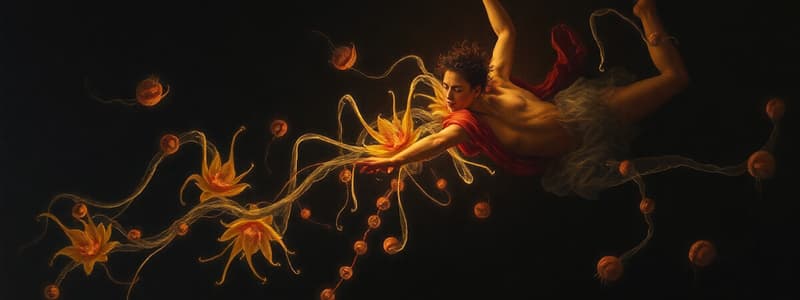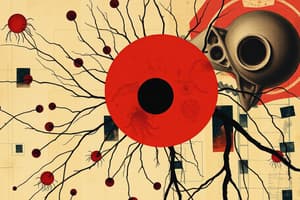Podcast
Questions and Answers
In follicular lymphoma, the overexpression of BCL-2 prevents apoptosis, leading to increased cell survival. Which of the following mechanisms best describes how BCL-2 achieves this?
In follicular lymphoma, the overexpression of BCL-2 prevents apoptosis, leading to increased cell survival. Which of the following mechanisms best describes how BCL-2 achieves this?
- By directly interacting with death receptors, such as Fas and TNF receptors, to initiate the extrinsic apoptotic pathway.
- By inhibiting the release of cytochrome C from the mitochondria, thus preventing apoptosome formation. (correct)
- By directly activating caspases, initiating the caspase cascade and promoting cell breakdown.
- By promoting the formation of apoptotic bodies, facilitating the engulfment of cellular debris by macrophages.
A researcher is investigating potential therapeutic targets for neurodegenerative diseases characterized by abnormal protein accumulation. Based on the information provided, which of the following strategies would be most effective in promoting the removal of damaged cells?
A researcher is investigating potential therapeutic targets for neurodegenerative diseases characterized by abnormal protein accumulation. Based on the information provided, which of the following strategies would be most effective in promoting the removal of damaged cells?
- Upregulation of TNF-alpha to directly induce necrosis.
- Inhibition of caspase-3 to prevent the execution of apoptosis.
- Knockdown of BCL-2 to promote cytochrome C release and caspase activation. (correct)
- Overexpression of BCL-2 to enhance cell survival and prevent apoptosis.
During a study of liver pathology, a pathologist observes a liver biopsy from a patient with viral hepatitis. Which specific set of morphological features would the pathologist expect to see in hepatocytes undergoing apoptosis?
During a study of liver pathology, a pathologist observes a liver biopsy from a patient with viral hepatitis. Which specific set of morphological features would the pathologist expect to see in hepatocytes undergoing apoptosis?
- Cellular shrinkage, basophilic cytoplasm, and extensive inflammation.
- Pyknosis, eosinophilic cytoplasm, and karyorrhexis. (correct)
- Cellular swelling, karyolysis, and neutrophil infiltration.
- Karyolysis, cytoplasmic fragmentation, and loss of membrane integrity.
A researcher is comparing the intrinsic and extrinsic pathways of apoptosis. Which statement correctly differentiates the key initiating events of these two pathways?
A researcher is comparing the intrinsic and extrinsic pathways of apoptosis. Which statement correctly differentiates the key initiating events of these two pathways?
During apoptosis, specific enzymes dismantle the cell in a highly regulated manner. What is the critical role of caspase-3 in this process?
During apoptosis, specific enzymes dismantle the cell in a highly regulated manner. What is the critical role of caspase-3 in this process?
Macrophages recognize and phagocytose apoptotic bodies through specific signals. Which signal is primarily responsible for targeting apoptotic cells for engulfment by macrophages?
Macrophages recognize and phagocytose apoptotic bodies through specific signals. Which signal is primarily responsible for targeting apoptotic cells for engulfment by macrophages?
A researcher is studying cells undergoing apoptosis and observes membrane blebbing but no rupture of the plasma membrane. How does this maintenance of membrane integrity contribute to the process of apoptosis?
A researcher is studying cells undergoing apoptosis and observes membrane blebbing but no rupture of the plasma membrane. How does this maintenance of membrane integrity contribute to the process of apoptosis?
A scientist is investigating the morphological changes associated with apoptosis and necrosis. Which of the following features is exclusively observed in necrosis but not in apoptosis?
A scientist is investigating the morphological changes associated with apoptosis and necrosis. Which of the following features is exclusively observed in necrosis but not in apoptosis?
In Huntington's disease, the accumulation of Huntingtin protein leads to neuronal damage and apoptosis. Which of the following molecular events is most directly involved in executing the apoptotic process in this disease?
In Huntington's disease, the accumulation of Huntingtin protein leads to neuronal damage and apoptosis. Which of the following molecular events is most directly involved in executing the apoptotic process in this disease?
A researcher is studying the effects of knocking down BCL-2 in cancer cells. Which of the following outcomes would be expected as a direct result of BCL-2 knockdown?
A researcher is studying the effects of knocking down BCL-2 in cancer cells. Which of the following outcomes would be expected as a direct result of BCL-2 knockdown?
Flashcards
Apoptosis
Apoptosis
A form of programmed cell death where the cell breaks down neatly without causing inflammation.
Caspase Cascade
Caspase Cascade
Enzymes activated during apoptosis to cause a clean cell death.
Intrinsic Pathway
Intrinsic Pathway
Mitochondrial pathway of apoptosis involving BAX and BAK proteins.
Extrinsic Pathway
Extrinsic Pathway
Signup and view all the flashcards
BCL-2
BCL-2
Signup and view all the flashcards
Pyknosis
Pyknosis
Signup and view all the flashcards
Karyorrhexis
Karyorrhexis
Signup and view all the flashcards
Necrosis
Necrosis
Signup and view all the flashcards
Karyolysis
Karyolysis
Signup and view all the flashcards
Membrane Blebbing
Membrane Blebbing
Signup and view all the flashcards
Study Notes
- Apoptosis is a form of cell death where a cell self-destructs.
- The objectives are to discuss the causes, mechanisms, and morphological features of apoptosis and also to differentiate the features of apoptosis from necrosis.
Key Terms
- Apoptosis means "to fall off" in the context of cell death.
- The caspase cascade involves enzyme activation that leads to clean cellular death without any inflammation.
- Intrinsic Pathway is a mitochondrial pathway.
- Extrinsic Pathway involves death receptors like Fas and TNF receptors.
- BCL-2 is an anti-apoptotic mitochondrial protein that helps cells survive and is often overexpressed in follicular lymphoma.
Mechanisms of Apoptosis
- The intrinsic pathway is mitochondrial.
- BAX and BAK proteins (BCL-2 family) cause cytochrome C to be released from the mitochondria which then binds to Apaf-1.
- After this, the apoptosome forms, activating caspase-9, which in turn activates caspase-3, leading to apoptosis.
- The extrinsic pathway involves death receptors
- T cells use the extrinsic pathway to trigger apoptosis in infected cells, particularly in viral infections.
- Caspase-9 is cleaved into caspase-9 which activates caspase-3, causing the cell to break down.
Apoptosis vs. Necrosis (Morphological Features)
- Apoptosis morphological features involve specific nuclear and cellular changes.
- Pyknosis involves nuclear chromatin condensation.
- Karyorrhexis involves nuclear fragmentation.
- Apoptotic bodies form.
- Cell membranes will start blebbing and the cytoplasm will fragment.
- Phospholipids on the cell surface act as "Eat me" signals attracting macrophages.
- Necrosis morphological features also involve nuclear and cellular differences.
- Karyolysis involves the fading away of the nucleus.
- Cellular changes include swelling, loss of membrane integrity, and inflammation.
- Karyolysis is unique to necrosis and not present during apoptosis.
- Apoptotic bodies form cleanly, unlike the debris that is formed by necrotic cells.
Key Points of Apoptosis
- Physiologic causes include the normal aging of cells while undergoing apoptosis.
- Remnants of apoptotic bodies are seen in the colonic epithelium during pathological examination.
- Pathologic causes include viral hepatitis where apoptotic cells have pyknotic, shrunken nuclei and eosinophilic cytoplasm.
- Huntington's Disease causes an accumulation of Huntington protein that damages neurons, which then leads to neurodegeneration.
High-Yield Points
- BCL-2 is an anti-apoptotic protein.
- Follicular lymphoma overexpresses BCL-2 in order to prevent apoptosis.
- Caspase-3 is an important part of the execution phase of apoptosis, and is important in diseases such as Huntington's.
- Senile cells undergo physiologic apoptosis.
- Viral hepatitis causes a pathological form of apoptosis that leads to characteristic cell morphology.
Morphology Tips
- Apoptosis results in pyknosis, karyorrhexis, and formation of apoptotic bodies.
- Necrosis causes karyolysis, membrane rupture, and inflammation.
Quiz/Practice
- Knocking down BCL-2 will promote apoptosis.
- Chromatin condensation happens first, and then fragmentation.
- Apoptotic cells display shrunken, eosinophilic cytoplasm and fragmented nuclei (e.g., in viral hepatitis).
Recap
- Apoptosis is a controlled process of programmed cell death.
- Two major pathways exist which are the Intrinsic (mitochondrial) and Extrinsic (death receptor).
- Apoptosis leads to clean cell death without causing inflammation.
- Key morphological changes include pyknosis, karyorrhexis, and apoptotic bodies.
- BCL-2 helps prevent apoptosis.
- The membrane remains intact in apoptosis and the cell contents are packaged into apoptotic bodies, preventing inflammation.
- In contrast, necrosis causes the cell membrane to be lost, leading to cell rupture, spilling of contents, and inflammation.
- BCL-2 inhibits the release of cytochrome C from the mitochondria, which prevents the formation of apoptosomes.
- Knocking down BCL-2 will cause cytochrome C to be released as well as caspase activation, leading to damaged cells being removed.
- Liver biopsies from patients with viral hepatitis will show hepatocytes that are in apoptosis.
- Expect to see pyknosis, eosinophilic cytoplasm, and karyorrhexis.
- The intrinsic pathway is triggered by intracellular signals leading to mitochondrial changes, and the extrinsic pathway is initiated by extracellular ligands binding to death receptors.
- Caspase-3 breaks down cellular organelles and the cytoskeleton which leads to apoptotic bodies forming.
- Phospholipids externalized on the cell surface are signals for macrophages to engulf apoptotic bodies.
Studying That Suits You
Use AI to generate personalized quizzes and flashcards to suit your learning preferences.




